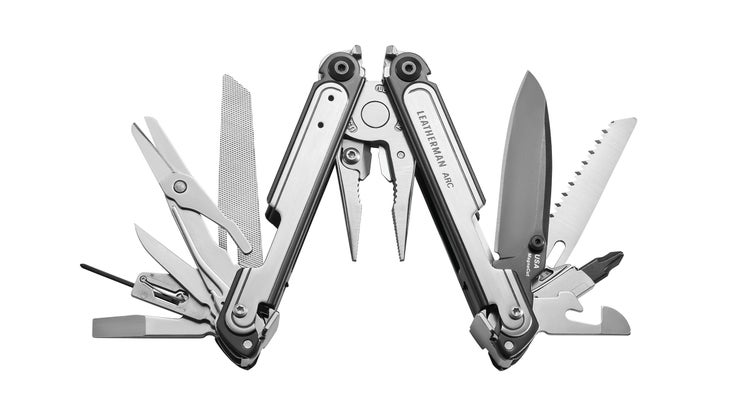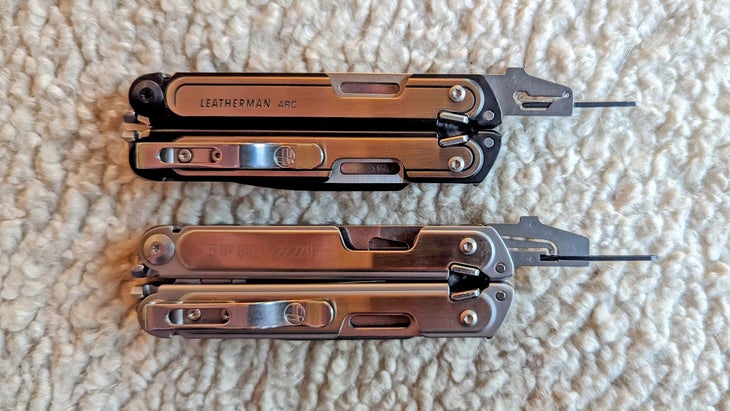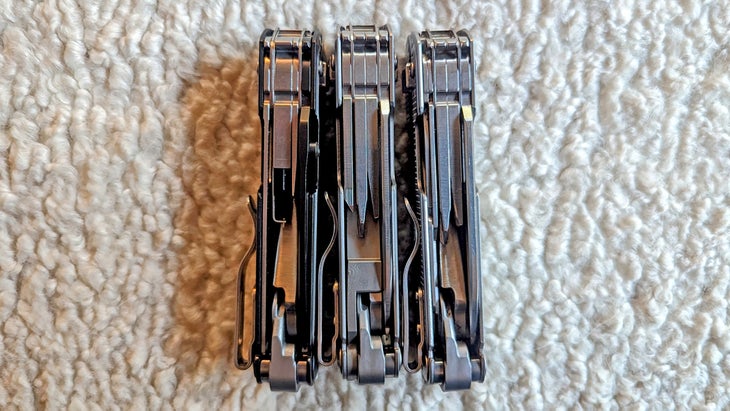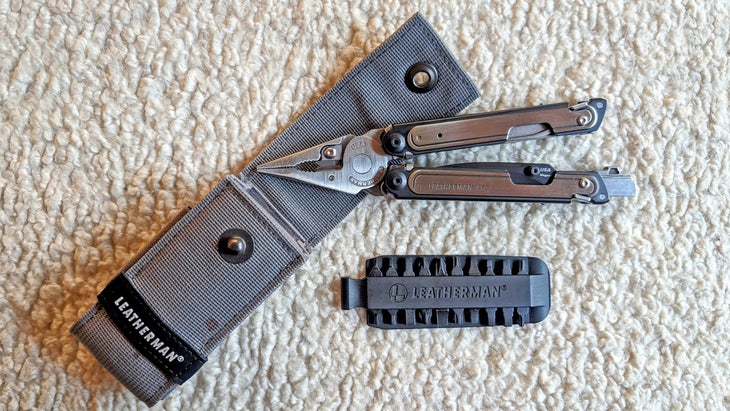No products in the cart.
Outdoor Adventure
Can the New Leatherman Arc Replace Your Trusty Pocket Knife?
Handy people know the multitool conundrum: Do you carry one in lieu of a quality pocket knife? If you forgo the knife, you’ll sacrifice good ergonomics, rapid access, and durable blades. But in exchange you’ll receive a more diverse array of tools.
That’s the problem Leatherman is trying to solve with the new Arc ($230). The multitool comes complete with a 2 3/4-inch knife blade made from CPM Magnacut—the latest, greatest, and trendiest steel on the market. Complete with a generous thumb stud, deep carry pocket clip, and an ideal tip-up, right-hand carry configuration, it attempts to combine a full-size multitool with a very good knife. But can it do so without compromise?
The Arc is an evolution of Leatherman’s Free P4 platform—first released in 2019. That tool uses magnets and redesigned tool access that make the thing operable one-handed, while also packing more tools than other models into a slimmer footprint. All that works exceptionally well. Reviewing that tool, we called it, “the only series of multitools you should consider.”
On top of the Free P4, the Arc adds a black-anodized body to give it a more upscale look, and has revised the tool selection based on customer feedback to add more utility. A new bit holder replaces the Free P4’s fixed flat and Phillips-head screwdrivers. Combined with an 20-tool bit selection housed in the included nylon sheath, this adds a diverse array of new capabilities.
“It made sense to put all of our best features and all of our best tools into into product,” explains Leatherman Senior Product Manager Jeremy Rodriguez.

I find the inclusion of the T10 Torx driver in that toolset particularly useful, allowing me to check tightness on the small screws that mount my Trijicon red dot sight to my handgun. Those are prone to coming loose if the gun gets knocked around outdoors, which switches the sight off. Being able to simply grab the Arc from my pocket, re-torque the screw, and bring the sight back to life saves a lot of headaches, and here in grizzly country, might even save my life.
There’s also a mini-bit driver which holds a double-ended eyeglass screwdriver, with both flat and Phillips heads. Housing such small tools inside a large, easily portably, one-hand accessible device means I have the ability to cinch up the arms on my Randolphs, and run less of a chance of losing one of the two tiny little screws that holds them together.
That mini-bit driver is adapted from the one first prototyped on Leatherman’s limited-edition Mr. Crunch tool, which was released as part of the company’s new Garage program last year. The purpose of Garage is to give the company a means to test new solutions and designs across a large numbers of users (500 Mr. Crunch’s were made), then gather user feedback to develop better tools. It’s nice to see that program bearing fruit so soon, and promises more user-centric innovation in the future.

But ultimately, the point of Arc is the blade. “CPM Magnacut maximizes edge retention, toughness, and corrosion resistance,” explains Leatherman Lead Design Engineer Peter Parker, on what makes that steel such an upgrade. Previously, knife steels have been able to optimize for one or two of those features, but not all three.
Other brands are rapidly adopting Magnacut for everything from large fixed-blade bushcraft knives to high-end pocket folders and chef’s knives. “It’s kind of expensive, that’s the tradeoff,” says Parker, going on to explain that it brings layers of new challenges to Leatherman’s manufacturing process, which explains the Arc’s price. Where the regular Free P4 retails for $150, the Arc adds $80 to that, mostly just to include the Magnacut blade.
I’ve been carrying the Arc for a few weeks, and have tried to use the knife on it as often as possible for everything from food preparation, to wild game processing, and cutting up cardboard boxes—a task which rapidly dulls most blades. And while I can report that it remains shaving sharp, that’s nothing new for Magnacut. Other blades in my connection made from that material have held up to months of daily use before going dull. Which leads us to another downside of Magnacut: It’s difficult to sharpen.

Where previous blades on Leatherman tools have been made from 420—a very basic stainless steel—and are terrible at edge retention as a result, they are at least simple to sharpen. I’ve failed at all attempts to return any Magnacut knife to anything approaching usefulness myself, and have been forced to seek the help of a professional.
Other than its use of Magnacut, the only remarkable thing about the Arc’s blade is the big thumb stud, which makes deploying the knife easy. The drop point and hollow grind are similar to the blade on the Free P4, as is the 2 3/4-inch length.
And, like any other multitool, the Arc remains less than ideal when considered purely as a pocket knife. While the clip is a good one, the handle is just too large and too awkward to provide much comfort or security, and even with the thumb stud, deploying the blade isn’t anywhere as slick as the mechanism achieved by by pretty much any quality folder.

If you’re used to carrying a real knife in you front pocket everywhere you go, the Arc probably isn’t going to replace that. Whether or not the presence of a Magnacut blade justifies the $80 premium is going to likely going to come down to your desire for owning the latest, greatest gadget, versus either your patience for relying on a professional sharpening service, or your skill performing that job.
The Arc represents a solid effort at refining the Free P4 platform, achieving the impressive trick of packing even more usefulness into a tool of the exact same size. But it still asks users to compromise ergonomics and convenience if they want to carry one in place of their pocket knife. Mine lives in my backpack, in the exact same pocket every multitool I’ve carried before has.
Source link

